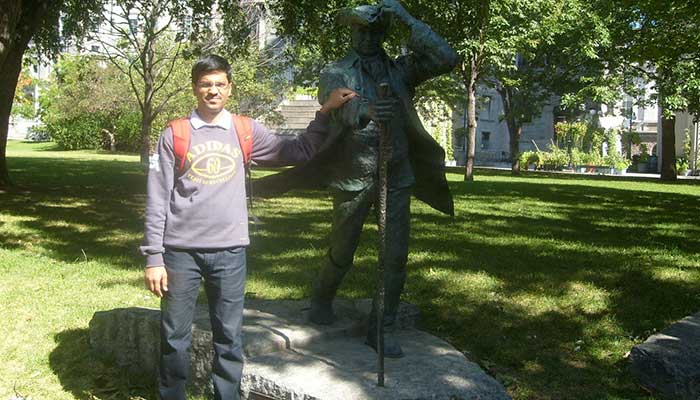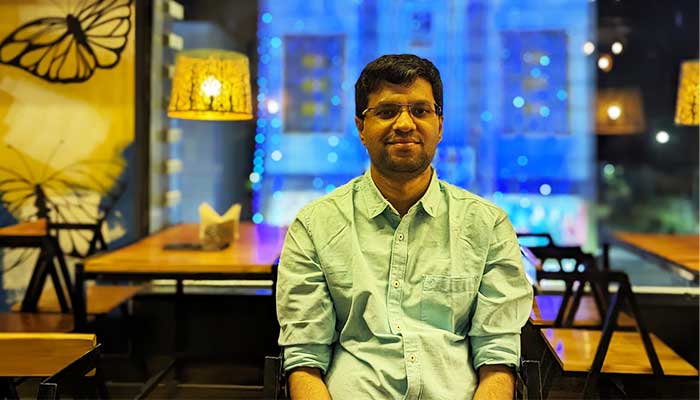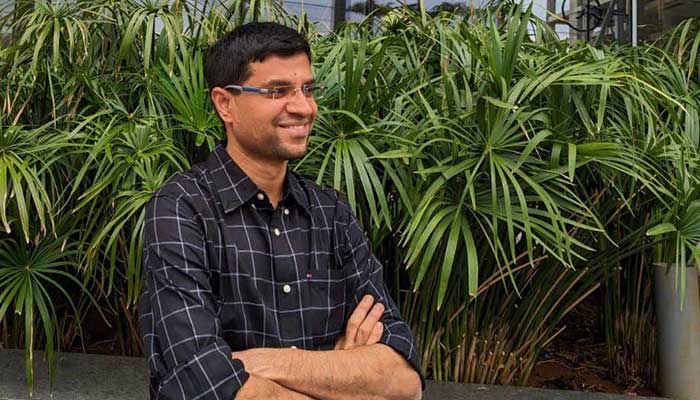Prof. Santosh Nannuru’s work in IIIT Hyderabad’s Signal Processing and Communications Research Center (SPCRC) is at the very core of the digital world that we live in. He builds algorithms that allows us to interpret the technologies of our connected world, including computers, cell phones, audio and video devices.
A Ph.D in Electrical Engineering from Montreal’s McGill University, Santosh Nannuru explains that while his primary work is in signal processing research, “we do have a range of projects that are specifically applicable to governmental agencies like the DRDO and in the defense industry, in radar and sonar signal processing.” A lot of his work leans towards the theoretical side, designing algorithms for specific applications in newer technologies including machine learning and artificial intelligence. The wide scope of his research interests include Compressive Sensing, Bayesian Analysis, Acoustic Signals, Array Signal Processing, Sparse Arrays, DOA estimation, Localization and Tracking, Particle Filters and Random Finite Sets.

Quite an electrifying journey
Growing up in the picturesque town of Chalisgaon in Maharashtra where his father had a Central Bank posting, Santosh did his schooling from the local Good Shepherd Academy. He moved to Ruparel college, Mumbai for his intermediate education and would take a year’s break to prepare for JEE.
The sabbatical paid off and Santosh joined IIT Bombay for a dual degree bachelors cum masters in Electrical Engineering (Communications and Signal Processing, 2004-09); earning the IIT Bombay Heritage Fund Scholarship for meritorious academic performance. He worked as a Design Engineer in his first job at iKoa Semiconductor India Pvt. Ltd, an audio engineering startup company. Within a year, it dawned on him that he was perhaps more inclined towards academic research.
“I enrolled in McGill University, Montreal for my Ph.D program. It was an enjoyable tenure involving both experiments and mathematical analysis with multiple collaborations”, says Santosh who was a recipient of the McGill Engineering Doctoral Award (MEDA). “I had a good bunch of lab-mates from almost 10 nationalities at McGill and it was an excellent place for cultural exchange. Along with a few friends, I would regularly commandeer the whole laboratory for our late night experiments, recording data for my thesis on multi-target multi-sensor tracking. I remember our frequent visits to Tim Hortons, a famous Canadian coffee chain, with my friends to see us through the lab work”.
Santosh did a short, eventful internship at Oxford University, when his Ph.D advisor moved there for a year’s sabbatical. “It was a lovely campus and I was fortunate to collaborate with a faculty member who was very famous in his research area”, he reveals.
Santosh moved to the Scripps Institute of Oceanography, University of California, San Diego for a 2.5-year post-doctoral stint, where he worked at the Marine Physical Lab on acoustic signal processing and sound signal analysis for directional interpretation. “We were using underwater hydrophones, and processing data to extract information from sound recordings, to locate the directions of ships and other marine activity. San Diego was a very wonderful stint and my office was practically on the beach”, he reminisces. “There was a robust multi-national community, a very kind and generous advisor, and I got to develop algorithms for various applications including underwater acoustics”.
Vista from the lens of a shutterbug
Photography was a passion acquired during Santosh’s conference visits to wonderful places like Turkey and Barbados in West Indies. “With over 25 conferences and workshops, apart from academic memories, it was a revelation every time. I would take my camera everywhere and would spend entire days, doing random street photography. One of my fondest memories was a week-long conference in Brighton, UK. I took the next week off to travel to nearby places, capturing a green meadow or a park and trying out the local cuisine,” reports Santosh who has a penchant for natural scenic locales and local museums. “While I was in Oxford, I travelled to London several times and did the museum rounds. There was so much to see; hundreds of rooms with paintings from all around the world, different eras and various styles”.
Exciting confluence of collaborative work
When Santosh decided to return to India, it was fortuitous that he snagged the coveted INSPIRE fellowship; a 5-year award given to post-doctoral researchers by the Indian government, that includes a nice salary and research grant. “I was planning to move to Hyderabad since my parents had settled down here and IIITH was one of the big names that popped up. As I browsed the website, I found that the Institute had an excellent faculty and research areas that were a perfect fit. The interview experience was pretty friendly and that’s how I landed here in IIITH in June 2018”, he observes.
Santosh is presently partnering with co-faculty in signal processing projects for the defense sector and has ongoing collaborations with his post-doctoral advisor at Scripps and a project with the University of Surrey, UK. “I’m lending my expertise for a government-funded Virtual Labs project, to develop computer simulations for experiments in signals and systems”. The premise is that students with limited access to resources should be able to learn concepts, with a computer or a phone, and internet connection.

A collaboration on the horizon is with the DRDO Labs on sonar signal processing. “I am interested in processing of signals irrespective of their origins. I am working with Dr. Praful from my Center on Radar signal processing”. Biomedical signal processing is a promising application area. Santosh is working with Dr. Kavita Vemuri from the Cognitive Sciences group on FMRI signal processing and with Dr. Chittaranjan Hens of CCNSB, on building intervention modules, by understanding epidemic patterns and the spread of diseases. “A couple of my students are working on astronomical signal processing; studying methods for detecting exoplanets. That’s very interesting”, he adds.
“I enjoy teaching and find it very rewarding”, observes the researcher. “I did not realize this until I joined IIITH as faculty. One of the most fulfilling moments is when at the end of the class, students come up with questions that I am able to answer and clear their doubts. The students in the class may not know it, but teaching is also a collaborative process where the exchange of questions and answers makes both the teacher and student a bit wiser. Many times, queries from students have led me down avenues of new learning and it has been deeply rewarding”.
Chilled life on campus
“City life is very hectic but inside the campus, it is a peaceful environment”, attests the scholar who has been living in IIITH’s green campus for the last two years. “The 10-minute walk to my office or lab is the nicest. The air is fresh, clean and pollution-free. I love my lunch time conversations in the canteens with other faculty. You get to interact with colleagues from other centers in an informal way, away from the professional setting. What makes all the difference is that everyone here is like-minded and it’s a very congenial and supportive ecosystem”.
Growing up with simplicity and grace
“I grew up in Chalisgaon, close to the ancient Buddhist hub of Ajanta and Ellora caves. I was not mature enough to appreciate the historical significance of the place, since it was just home to us, as small children”, he confesses. “I was known to be studious, silent and sincere as a child. I had a few close friends and our days were spent in playing games and chatting. One very positive influence in my life was my science and maths teacher at school who believed in me and taught in a very fundamental manner, that was most appealing. In my undergraduate and Masters’ days, there was also that phase when I listened to a lot of inspiring Carnatic and Hindustani classical and had even taken a course in Introduction to music”.
Something that Santosh believes is a blessing in disguise, is his inability to switch to work mode when he is at home. “Typically, I wrap up my work at office. At home, it’s only family time with my wife who works in the field of scientific writing and our 8-month old toddler. It gives me immense joy to capture her milestone moments on reel. We enjoy relaxing with a movie, a drama series, comedy or detective shows like Monk. My wife is the more organized one, and is in charge of all planning and scheduling. I just take things as they come. She keeps things real”, he grins. “My go-to fitness regimen is walking and a round of badminton sometimes”.
A bookworm and his wish list
Santosh loves reading fiction and prefers award-winning authors. “I try to balance my reading between Indian and foreign titles, as well as getting different perspectives from various countries and continents. But I lean towards thought-provoking storylines, different kinds of fiction – from drama to fantasy. I love to learn about random things in science and mathematics and am curious about things outside the purview of my work”, he discloses.
“While my primary work is in signal processing, in recent times newer domains for confluence have opened up in machine learning and artificial intelligence”, he observes. “Can we use existing techniques in signal processing which have a sound pedagogical foundation, to deconstruct novel techniques which are not yet understandable? Integrating the more classical signal processing techniques with emerging trends is something that I’m looking forward to, in the future”.


Deepa Shailendra is a freelance writer for interior design publications; an irreverent blogger, consultant editor and author of two coffee table books. A social entrepreneur who believes that we are the harbingers of the transformation and can bring the change to better our world.


I am a research student under Santosh Sir, and it feels great to read this article about him. He’s a very calm person, with a broad field of knowledge.
When I go to him with some problem, very patiently he sits and first listens to all that I have to say, understands what is being done, then recommends changes. Almost immediately everything starts falling into place.
I am very happy to be working with him.
Aditya Ranjan Padhi says:Very comprehensive and complete write up, the reading is very fast and the contents are really thrilling
G R KORWAR says:Very inspirational academic journey. Great to know that you have landed in IIIT Hyderabad a premier institute for IT professionals.
Narayan Gadagkar says:Happy to see Santosh has achieved so much in short time. He is very sincere and very much dedicated to his job. I know him since his childhood. All the best and wish you all dream comes true. I am confident that he will contribute lot to make life easy all of us.
Rupendra Singh Kushwah says:Thanks for sharing this blog.